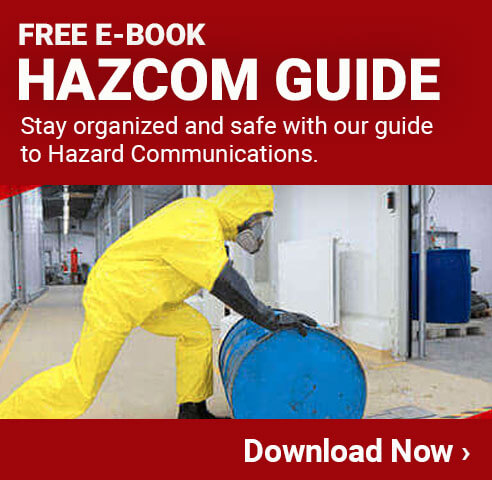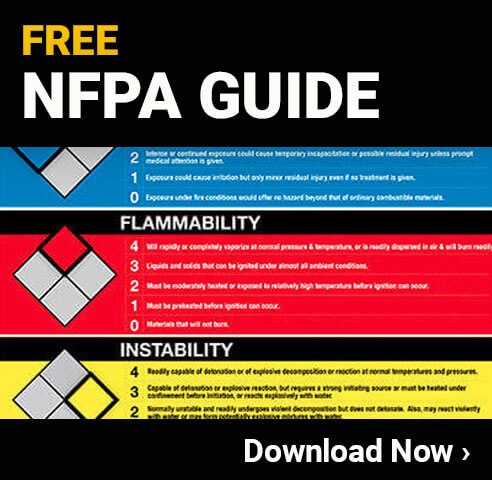
Text From Infographic
The NFPA 704 Diamond Explained
Purpose
The NFPA 704 diamond can be used on any type of chemical container to alert people to the specific hazards present.
It is intended to provide emergency responders with information that allows them to determine what special equipment or protections should be used in the event of a spill, fire, or other emergency situation.
Where are NFPA 704 labels used?
One of the most common places we see NFPA diamond labels is on trucks that carry chemicals. If the truck gets in an accident, the NFPA diamond lets emergency responders know what they're dealing with.
You may also see NFPA labels in warehouses, manufacturing facilities, schools, construction sites, retail stores, gas stations, and on chemical containers.
Is it required?
The NFPA 704 system is not required. The NFPA is not a governmental agency and it has no specific enforcement powers.
Why do companies use it? While the NFPA 704 standards are voluntary, most companies that deal with hazardous materials use this system because it is effective and can dramatically improve the safety of many environments.
Can it be used with other labeling systems? Because the this labeling system is supplementary, it can be used along with other label systems.
What does OSHA say? OSHA specifically says these labels can be used along with the other requirements laid out in its HazCom 2012 Standards (which includes the GHS Label Requirement).
How do you read the NFPA 704 Diamond?
Each of the four sections is a different color and are used to indicate different types of hazards. Each section (except “Special Notes”) is filled in with a number between 0 and 4, which indicates the level of hazard that exists. The lower the number, the lower the hazard.
Health Hazard - Blue
4 - Very short exposure could cause death or serious residual injury even though prompt medical attention is given.
3 - Short exposure could cause serious temporary or residual injury even though prompt medical attention was given.
2 - Intense or continued exposure could cause temporary incapacitation or possible residual injury unless prompt medical attention is given.
1 - Exposure could cause irritation but only minor residual injury even if no treatment is given.
0 - Exposure under fire conditions would offer no hazard beyond that of ordinary combustible materials.
Flammability - Red
4 - Will rapidly or completely vaporize at normal pressure & temperature, or is readily dispersed in air & will burn readily.
3 - Liquids and solids that can be ignited under almost all ambient conditions.
2 - Must be moderately heated or exposed to relatively high temperature before ignition can occur.
1 - Must be preheated before ignition can occur.
0 - Materials that will not burn.
Instability - Yellow
4 - Readily capable of detonation or of explosive decomposition or reaction at normal temperatures and pressures.
3 - Capable of detonation or explosive reaction, but requires a strong initiating source or must be heated under confinement before initiation, or reacts explosively with water.
2 - Normally unstable and readily undergoes violent decomposition but does not detonate. Also, may react violently with water or may form potentially explosive mixtures with water.
1 - Normally stable, but can become unstable at elevated temperatures and pressures or may react with water with some release of energy, but not violently. Materials that will not burn.
0 - Normally stable, even under fire exposure conditions, and are not reactive with water
Special Notes - White
The NFPA 704 Standard defines the following symbols:
OX - Oxidizer (e.g., potassium perchlorate, ammonium nitrate, hydrogen peroxide)
W - Reacts with water in an unusual or dangerous manner (e.g., cesium, sodium, sulfuric acid
SA - Simple asphyxiant gas. Limited to the following gases: nitrogen, helium, neon, argon, krypton & xenon
Non-Standard Symbols:
Corrosive; strong acid or base (e.g. sulfuric acid, potassium hydroxide)
Biological hazard (e.g., smallpox virus)
Cryogenic (e.g. liquid nitrogen)
Radioactive (e.g., plutonium, uranium)
Poisonous (e.g. Strychnine)
Similar Infographics
- Pipe Marking 101: Why is Pipe Marking Important?
- Eye Injuries in the Workplace
- 10 Astonishing Facts about Arc Flash
- The Importance of Industrial Label Printers
- Heat Stress
- 10 Most Hazardous Jobs in the US in 2018
- GHS Timeline: What’s Next?
- Lockout/Tagout Safety
- Top 10 OSHA Violations in 2019


